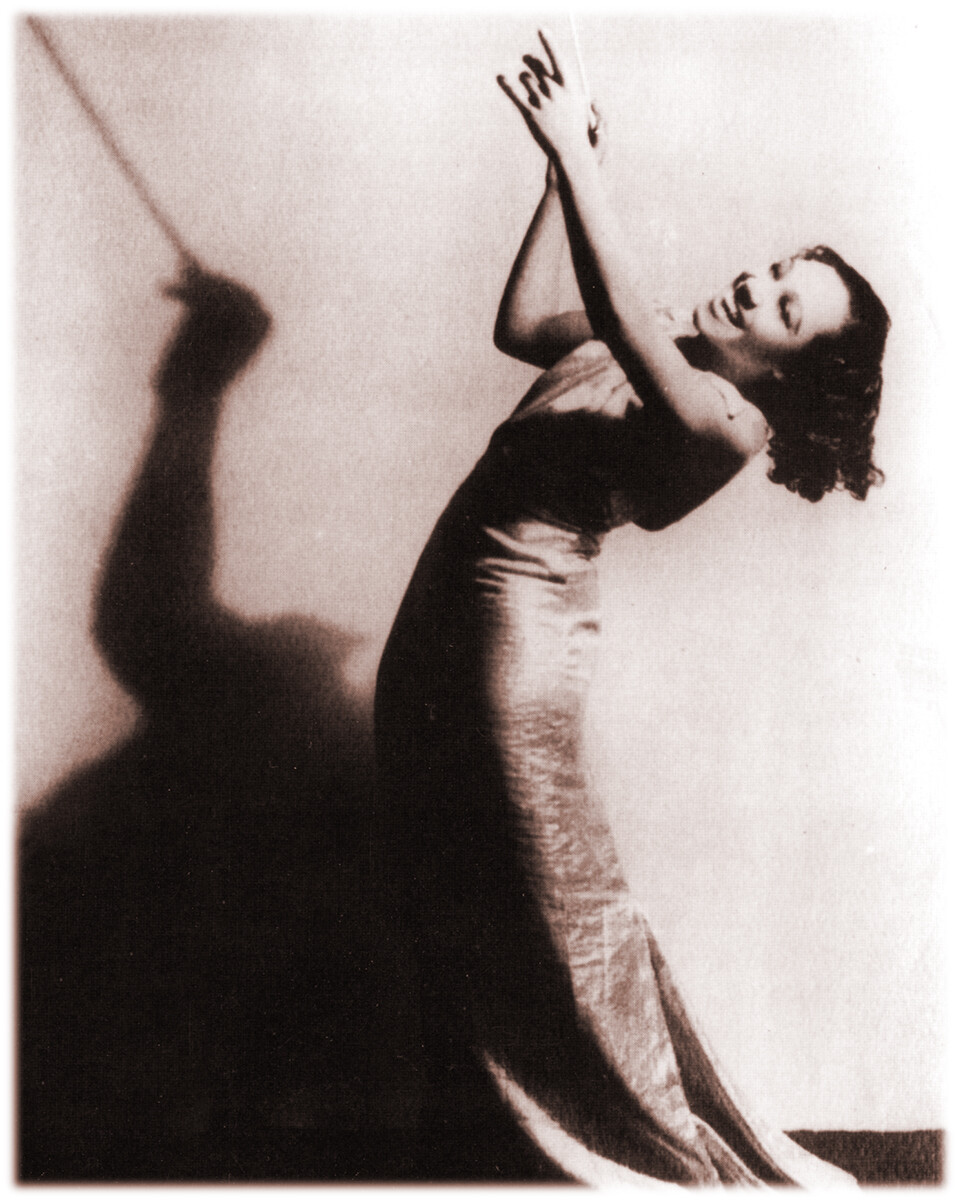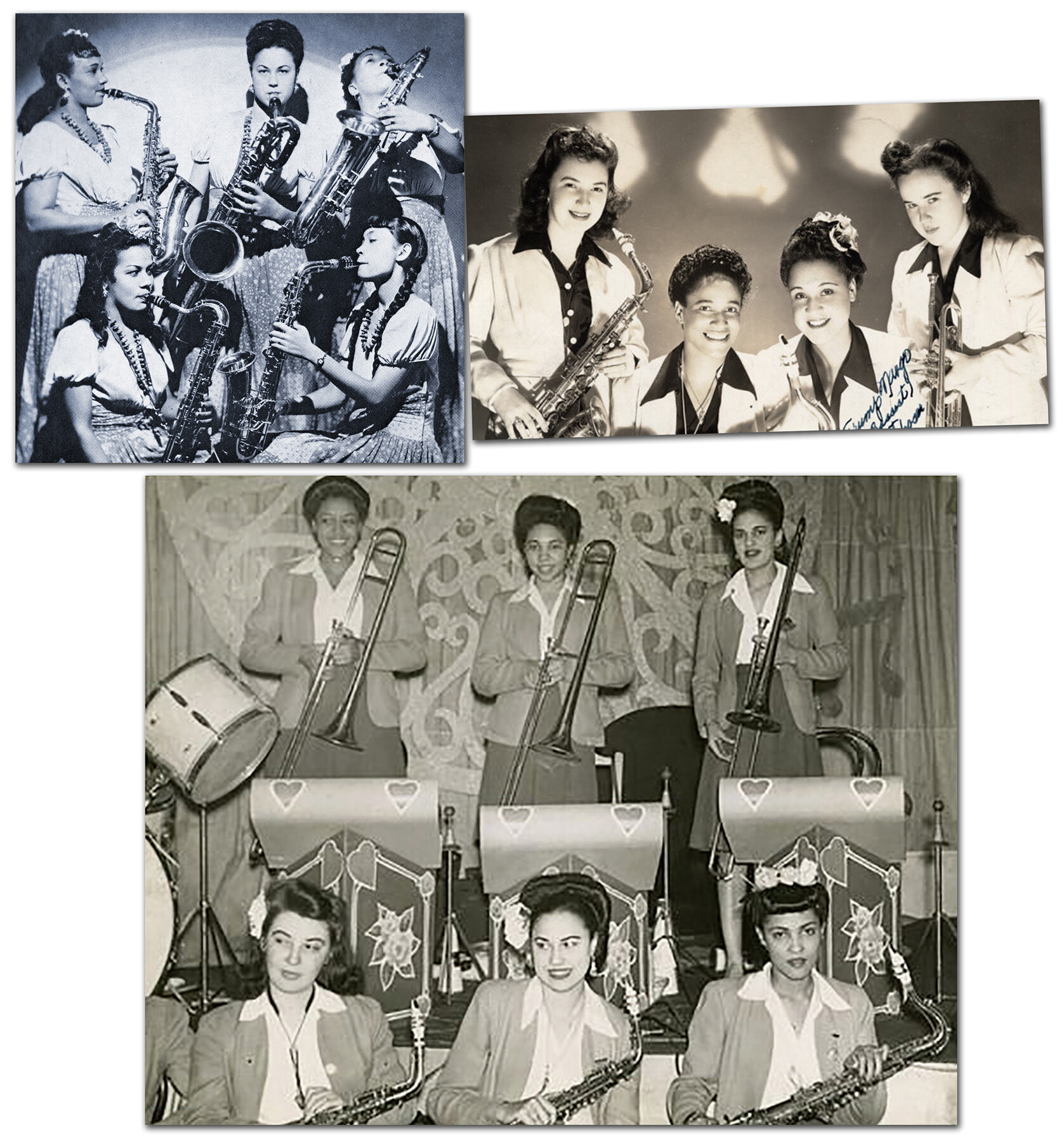Concealed in the shadows of Jazz and Blues history are dynamic women who nurtured, guided and developed the music. Several of the most talented and accomplished are profiled including Blanche Calloway, the first woman to lead an all-male jazz band; “Empress of the Blues” Bessie Smith; the Basie-style International Sweethearts of Rhythm, the high-water mark of the “all-girl” orchestras; and Ina Rae Hutton, leader of the all-female Melodears Swing orchestra.
Blanche Calloway: The First Woman to Lead an All-male Band
Singer, composer and bandleader Blanche Calloway (1902-1978) is recognized today as the first woman to successfully lead an all-male Jazz orchestra under her own name. Waxing a couple dozen sides, Blanche Calloway and Her Joy Boys were quite successful working out of Kansas City in the Midwestern region during the early 1930s. But she was eclipsed by the superstardom of her much more famous younger brother.
Cab Calloway borrowed key elements from his elder sister’s act — her bravura vocal style and Hi-de-Ho call-and-response motifs. In his memoir (Of Minnie the Moocher and Me, 1976) Cab acknowledged Blanche’s influence, declaring her an all-around entertainer who was “vivacious, lovely, personality plus and a hell of a singer and dancer . . . fabulous, happy and extroverted.”
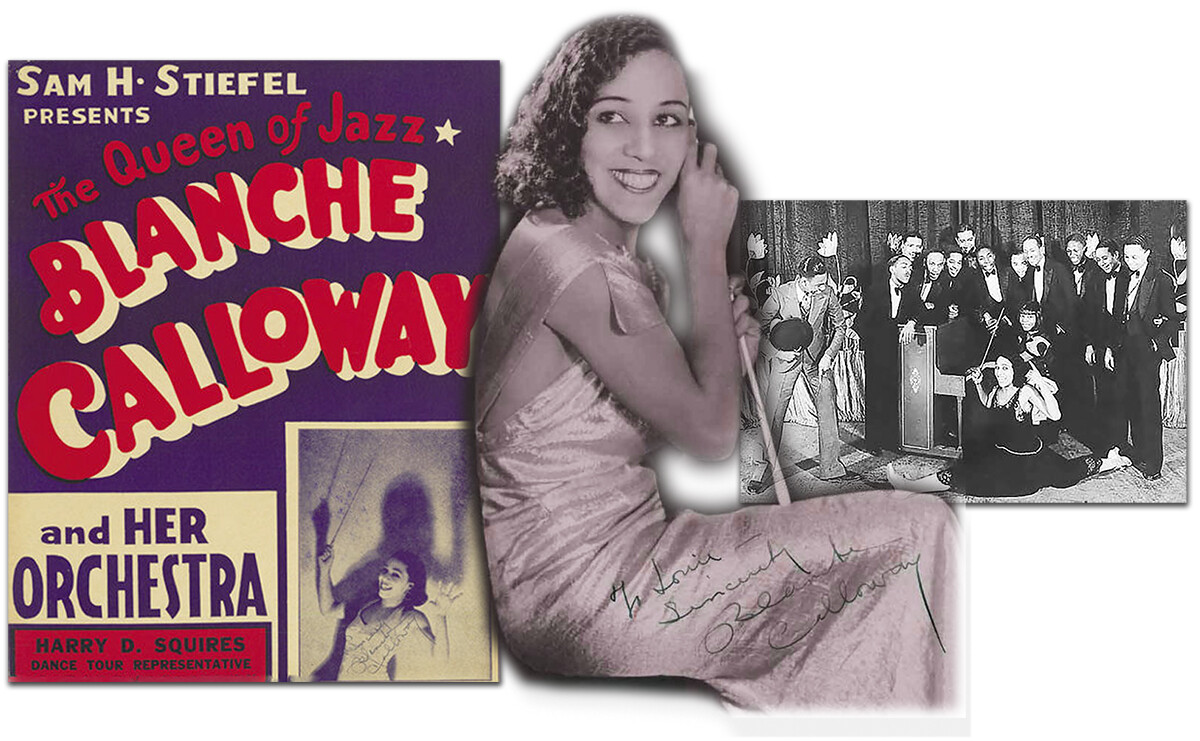
Blanche dropped out of college to enter show business with a Cabaret troupe, subsequently appearing in Sissle and Blake’s black musical show “Shuffle Along” and the touring edition of “Plantation Days.” Calloway was very successful in New York, and in Chicago during the early 1920s where she performed at the prestigious Sunset Café and made a blues record with Louis Armstrong on cornet.
Her early 12-piece band consisted of personnel often interchangeable with Andy Kirk and The Clouds of Joy which featured pianist and arranger Mary Lou Williams (featured in part two). But Calloway split off. She was one of the first to hire young Kansas City tenor saxophonist Ben Webster in 1931, heard on “Just a Crazy Song.” Trombonist Vic Dickenson is featured in “I Need Lovin’.” Both songs were probably arranged by talented trumpet player and arranger Edgar “Puddinghead” Battle who later wrote for Cab.
Just a Crazy Song (Hi-Hi-Hi) (1931)
I Need Lovin’ (1934)
Though her last orchestra disbanded in 1938, Calloway briefly ran an all-women ensemble during World War II. She remained engaged with the entertainment industry, running bands into the 1950s and managed the career of her protégé, R & B singer Ruth Brown.
Retiring to Miami in the 1950s, Calloway became active in civil rights and was the first black woman to vote in the State of Florida, in part through her own efforts. In the 1960s she was the only African American female disc jockey on the air in Florida, possibly the entire Southern United States — and ran her own cosmetics company.
Blanche Calloway’s scintillating 1931 “Growlin’ Dan” contains proto-Minnie the Moocher imagery, showing again the deft arranging and growling trumpet of Edgar Battle. “You Ain’t Livin’ Right” is from her last recording session in November 1935.
Growlin’ Dan (1931)
You Ain’t Livin’ Right (1935)
International Sweethearts of Rhythm: The Best ‘Girl Band’ of World War II
The International Sweethearts of Rhythm (1937-49) were a racially mixed all-female 16-piece ensemble. Cast in the image of the Count Basie Orchestra — which is evident in their rhythm style, riffing and the powerful Lester Young-inspired tenor saxophonist Viola Burnside. Among their onstage MCs were vocalist Anna Mae Winburn, who had previously led an all-male band and was a follower of Kansas City blues singer Jimmy Rushing.
Jump Children (1945)
She’s Crazy with the Heat (1945)
The orchestra originated at the Piney Woods School of Mississippi for poor boys and girls. As the ensemble matured, it moved to Virginia and began attracting professionals. During World War II most of the male musicians in the band (and across America) were drafted. Resuming as the all-female International Sweethearts of Rhythm, they became more successful than before — the tag ‘international denoting their diverse ethnic makeup that included Hispanic, Asian, Native and African American women.
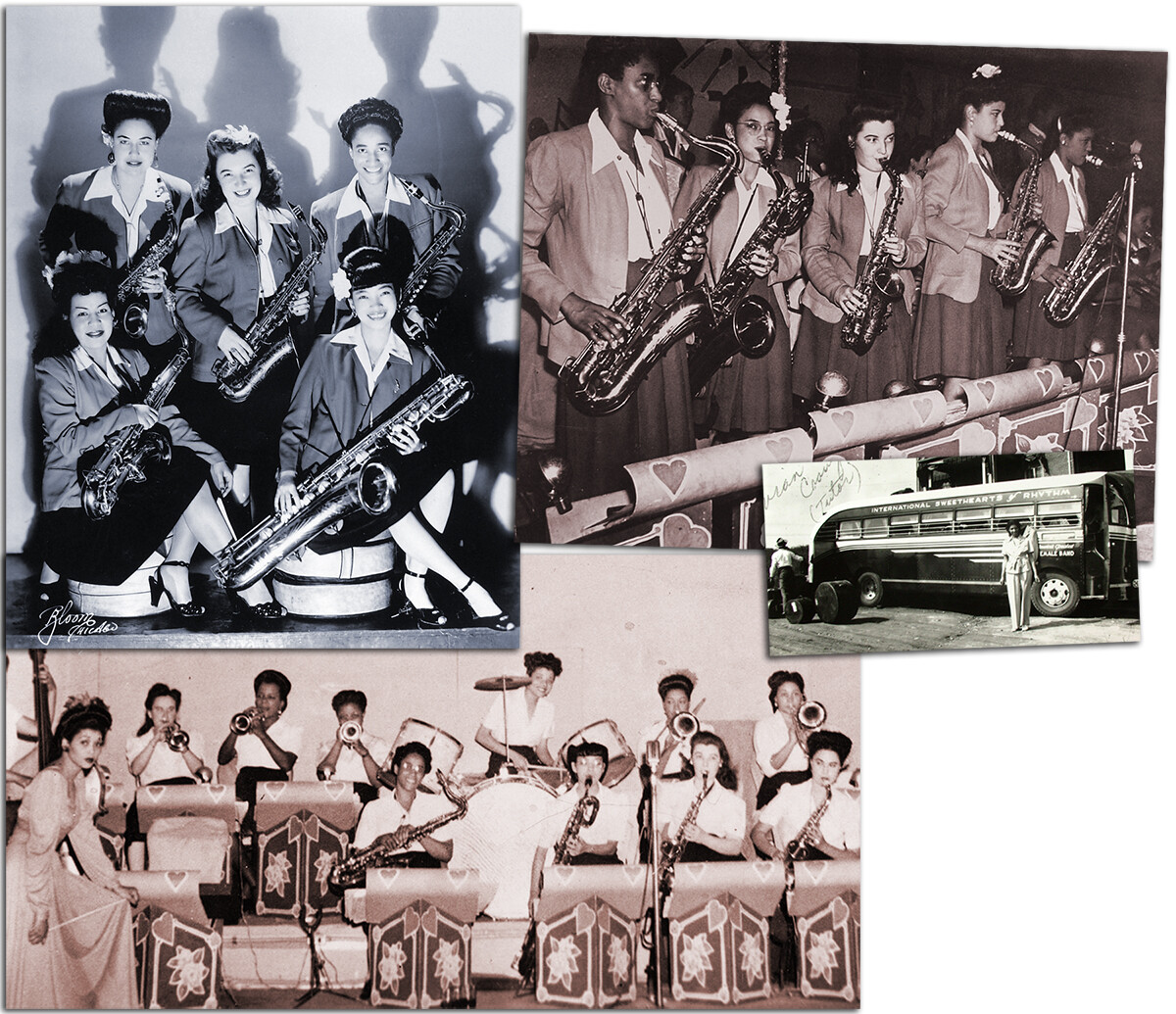
They were excellent musicians who played tough charts, some written by arranger Eddie Durham of the Basie orchestra who also ran a closely related all-women ensemble. For the duration of World War II “girl bands” were a popular and strategic reserve of American morale-building. Even the US Army sponsored and organized all-female ensembles.
Touring the Southern United States often, the mixed-race International Sweethearts were subjected to racist local Jim Crow segregation laws imposing vile restrictions on their access to public dining, lodging and sanitary facilities. When in the South, Caucasian girls wore dark makeup on stage to conceal the prohibited mixing of white and non-white women.
Sweethearts Clip (1944-46) – Diggin’ Dykes, Central Avenue Boogie, Vi Vigor, Bugle Call Rag
For a long time, recordings by the International Sweethearts were unavailable. Most of the extant performances have survived thanks to V-Discs — the patriotic consortium of record labels and music artists that produced entertainment for distribution to American troops during the Second World War. A signature of that origin remains audible in the sometimes-canned live applause and announcers’ attempts to sound “hep to the jive.”
Beginning around 1940 the popular orchestra performed at the famed Apollo Theater in Harlem and across America — once appearing for an audience of 11,000 in Kansas City. After the Second World War they toured American USO clubs in Europe in response to overwhelming demand from African American soldiers. The International Sweethearts of Rhythm were a high-water mark for the popularity and quality of all-female Swing ensembles.
Bessie Smith: ‘Empress of the Blues’
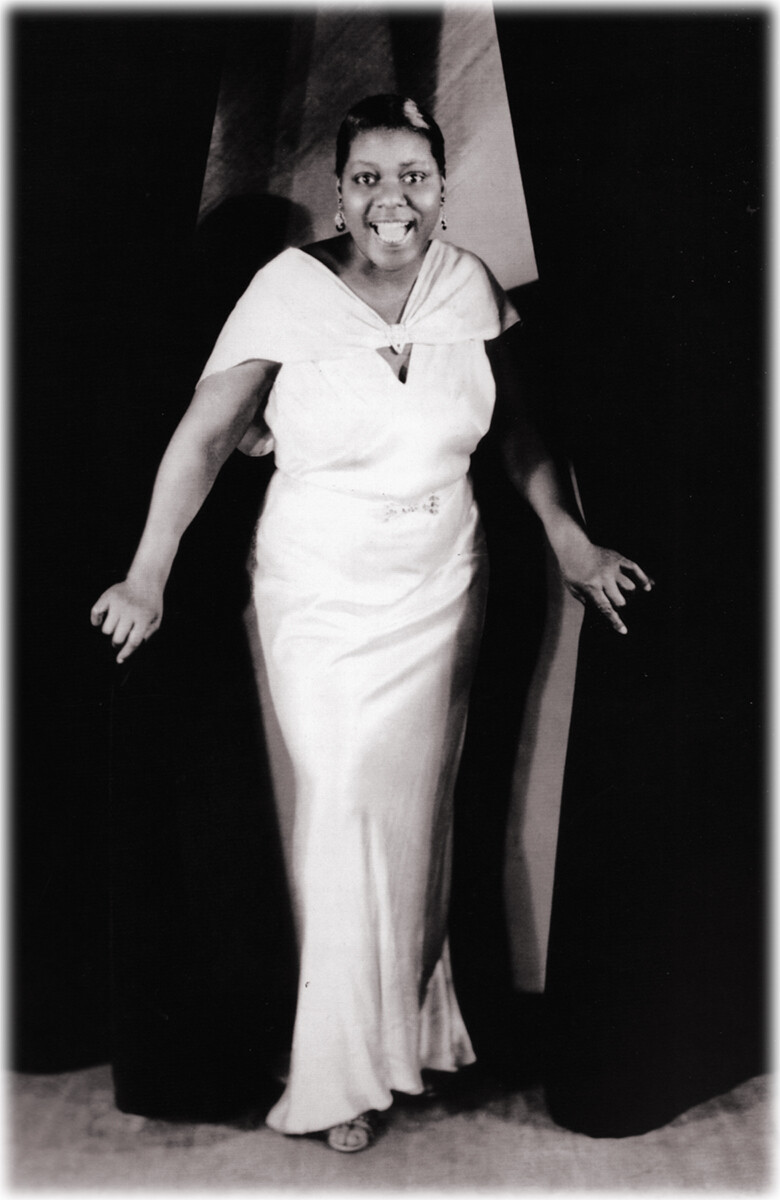
In 1923 the first recording by Bessie Smith(1894-1937) in 1923, “Downhearted Blues” written by Alberta Hunter, was a smash hit, allowing Smith to raise her performance fees from a few dollars to upwards of $2,000 per week. Six million of her records were sold during the next six years.
Bessie started out at the age of nine, singing for spare change on the streets of her hometown Chattanooga, Tennessee. She joined the tent show of Ma Rainey and as protégé to the charismatic older singer absorbed the Classic Blues style — a raunchy, rowdy, stomping, sobbing, tough-hearted celebration of uncensored emotions and in-your-face sensuality.
Cutting about 200 records, Smith had great musicians for her studio sessions — remarkable African American bandleaders, pianists and instrumentalists like James P. Johnson and the young Louis Armstrong. Her subtle vocal phrasing, tone quality, vibrato and rhythm were a definitive statement of the Classic Blues.
Wasted Life Blues (1929)
Black Mountain Blues (1930)
Bessie was known as a brawler who could quickly turn mean when drinking. If provoked she might knock you down or shoot a pistol at a lover — male or female. A hardy survivor, Bessie managed her own traveling tent show employing a troupe of musicians, dancers, entertainers and stagehands.
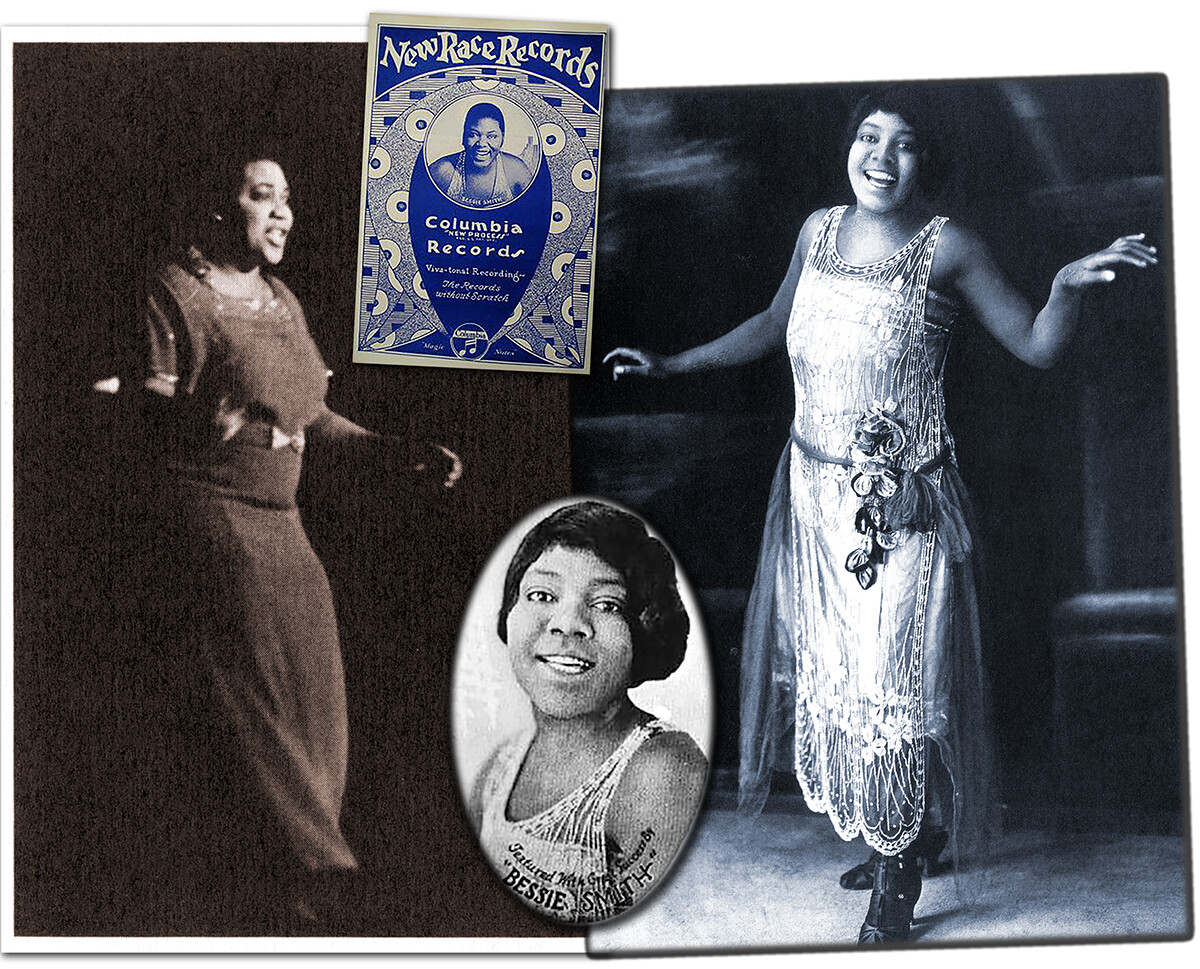
On one occasion, Ku Klux Klan thugs threatened to halt her show and knock the tent down. After they intimidated her roustabouts, Smith took on the thugs herself, sending the bullies running with threats and invective.
Bessie mesmerized her audiences in performance and on record. Dressing in flamboyant style, her delivery was direct and intense. “She dominated a stage,” said guitarist Danny Barker “You didn’t turn your head . . . You just watched her. She could bring about mass hypnotism.”
Bessie Clip A – I Need a Little Sugar in my Bowl (1931), Trombone Cholly (1927)
Leaving an indelible impression on Jazz, Blues, Popular and Country music, Bessie Smith was without peer for expressing powerful emotions, despite the limited span of her vocal range. Her records spread the Classic Blues beyond the Southern United States and around the globe — her voice transcending language, context and geography.
There is some truth to the fanciful suggestion of early jazz scholars that the music developed when horn players began emulating the blues cadences and bent notes of blues singers. And a rich literature celebrates Bessie as a source of racial pride, fierce feminist icon and enduring symbol of gender rebellion. Women’s Classic Blues was the vanguard of a new and personal musical art, generating eloquent masterpieces that still move us today.
Bessie Clip B – Backwater Blues (1927), Baby Doll (1926)
More Classic Blues Singers Named ‘Smith’
By the end of the 1920s there were hundreds of Bessie Smith imitators. Several shared her surname.
Billed as “Queen of the Blues,” Mamie Smith (1883-1946) was a dancer, singer, pianist and actress who began in vaudeville at age 10. She moved to Harlem in 1913 and was the first African American to make a Blues record. In 1920 Mamie recorded “Crazy Blues” which sold 1,000,000 copies. Though musicians for the session were Caucasian, Mamie had many sessions backed by seminal black jazz instrumentalists.
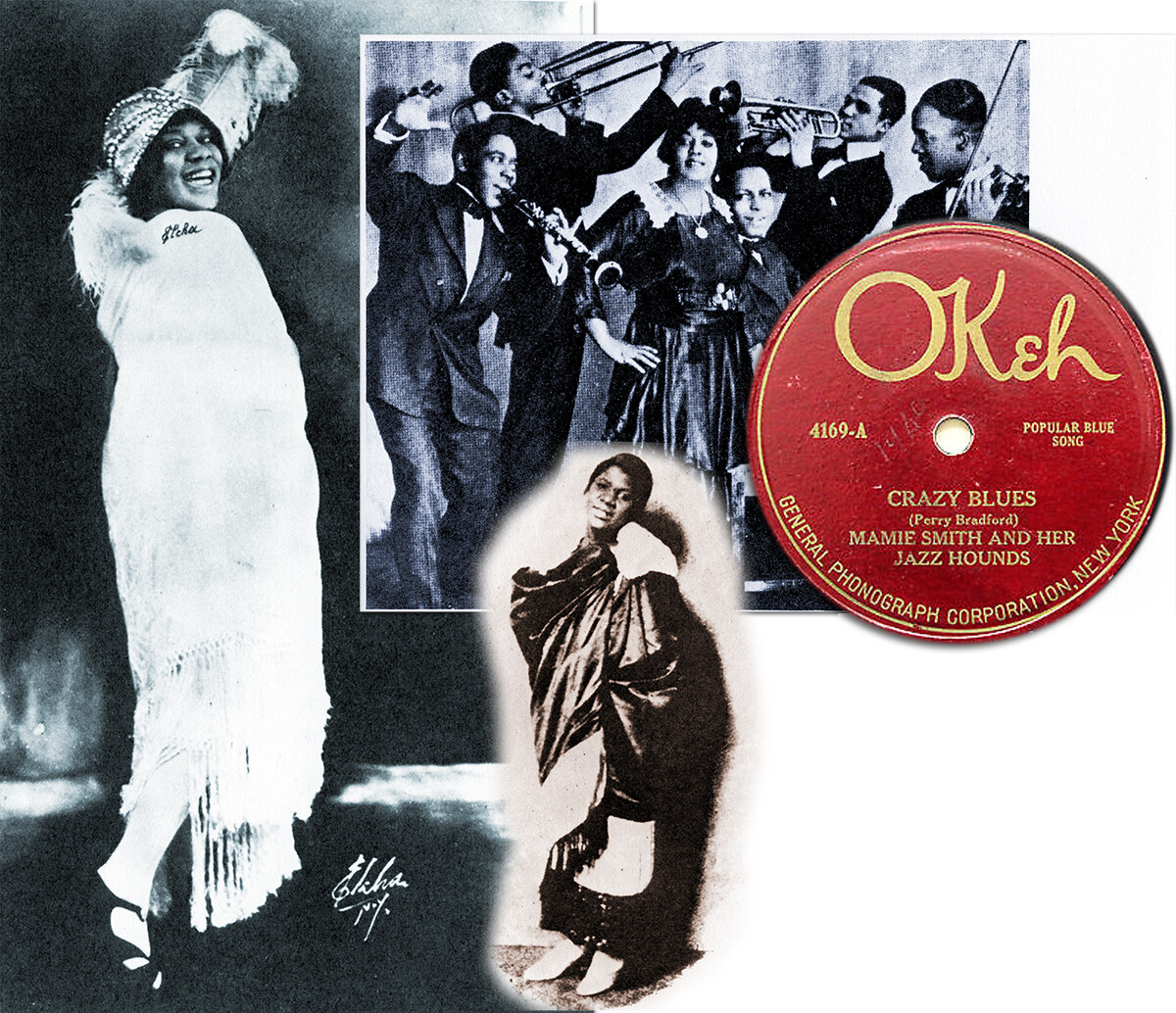
The massive commercial success of “Crazy Blues” paved the way for a new market. The record companies began producing, promoting and selling discs for African American and other minorities, inventing a category they called “race records.” Nonetheless, Mamie was an early crossover artist who succeeded with white audiences, possibly due to her successful radio career. Today her “Crazy Blues” is on the National Registry of historic songs at the Library of Congress and in the Grammy Hall of Fame.
Mamie Smith – Crazy Blues
Trixie Smith (1895-1943) began her career working in vaudeville and minstrel shows. She cut three dozen discs for the Black Swan, Paramount and Decca labels between 1921-25. “Trixie’s Blues,” “Railroad Blues” and “The World’s Jazz Crazy and So am I” were her biggest hits and she appeared in five films between 1932-38.
Trixie was accompanied on disc by stellar early jazz musicians — cornetists Joe Smith and Louis Armstrong, Sidney Bechet (reeds) and bandleaders Fletcher Henderson (piano) and James P. Johnson (piano) as well as white jazzmen Miff Mole (trombone), Phil Napoleon (trumpet) and Frank Signorelli (piano).
Promoted as “Queen of the Moaners,” Clara Smith (1894-1935) recorded 122 Blues songs for Columbia Records with distinguished jazz musicians, and toured coast to coast. Laura Smith (1882-1932) and her Wildcats recorded some 35 songs for OKeh and Victor labels, from 1924-27.
Ruby Smith (1903-1977) was a niece of Bessie Smith by marriage. Bessie discouraged her from going onstage, but Ruby did so anyway after her aunt Bessie passed on. On record Ruby was accompanied by James P. Johnson on piano for some 21 sides recorded between 1938 and ’47, enjoying minor celebrity thanks to her former close proximity to Bessie.
The popularity of women’s Classic Blues fell off after the late 1920s as tastes shifted, fortunes of the predominantly rural and African American audience declined, and record companies lost interest. Nonetheless, a niche market supported specialty and sporadic recording until other forms gradually eclipsed Classic Blues in the late 1930s.
Hour of Charm: The Best-known All-Women Orchestra
The Hour of Charm Orchestra (1934-1949) is included primarily for contrast to these other more ‘organic’ ensembles and musicians. Popular and successful, they were probably the best-known of the all-women ensembles of the 1930s and ‘40s heard regularly on the CBS and NBC networks and Armed Forces Radio during World War II.
Hour of Charm was the confection of Phil Spitalny, a Russian immigrant conservatory-trained classical musician. Touring, performing and broadcasting coast-to-coast, they played mostly light classics, choral hymns, middlebrow arrangements of popular standards, patriotic fare and inflated caricatures of jazz.
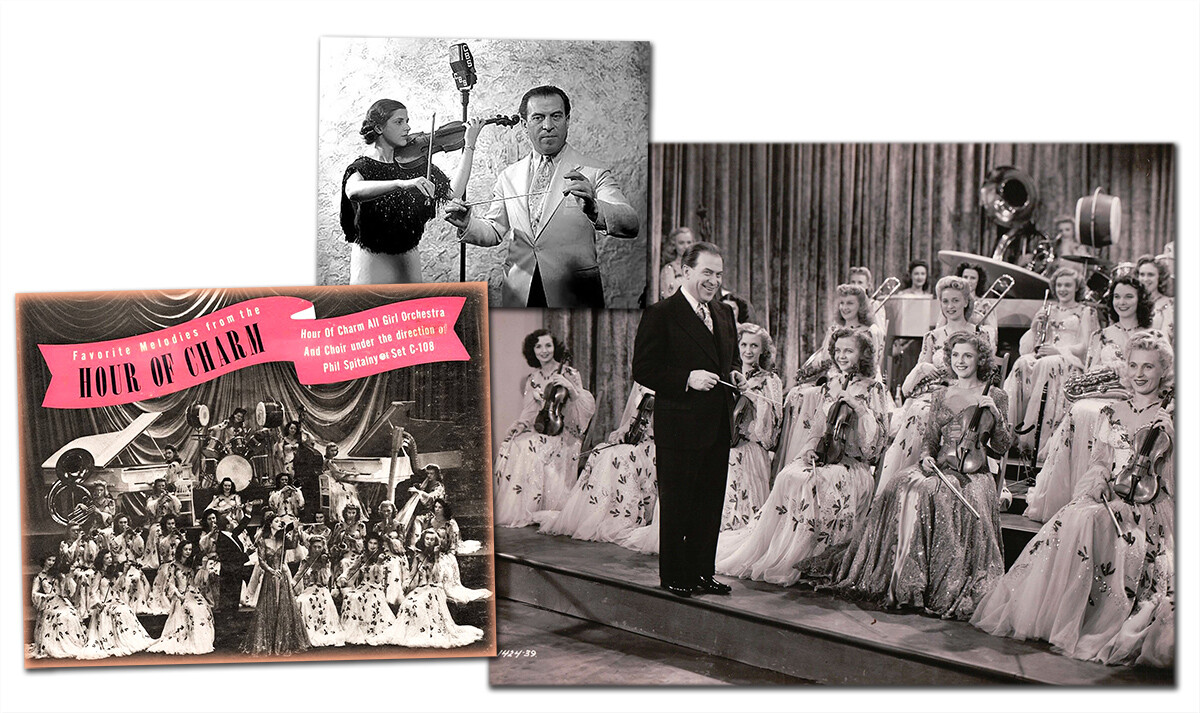
Hiring only conservatory graduates, Spitalny claimed that 1500 candidates had been auditioned for his orchestra, which ranged from 22 to 45 or more musicians and singers. They performed in white evening gowns, the scores were memorized, and no sheet music was seen on stage.
The musicians all sang in the chorus and played multiple instruments (one played twelve). A committee of five band peers monitored the dating activities of the young women – mostly unmarried by contract. In her book, Swing Shift: “All Girl” Bands of the 1940s, Sherrie Tucker interviewed former employees of Spitalny.
Viola Smith was a successful professional drummer before and after her 13 years with the Hour of Charm. She recalled, “a lovely life. Because you worked hard, but we played hard. We had so much free time. We had a few summers off.” She received advanced private musical tutoring from experts in the Count Basie Orchestra, Julliard School and the NBC Symphony. As the featured soloist of “Sing, Sing, Sing” she was paid above union scale.
By contrast trumpet player Vernell Wells, who was a veteran of several traveling “all girl” bands, found the maestro “high strung,” recalling her arduous decade with the orchestra as strenuous, “we were under terrific pressure.” Nonetheless, she also was privately tutored by elite musicians from the NBC Symphony and New York Philharmonic orchestras.
Hour of Charm – A
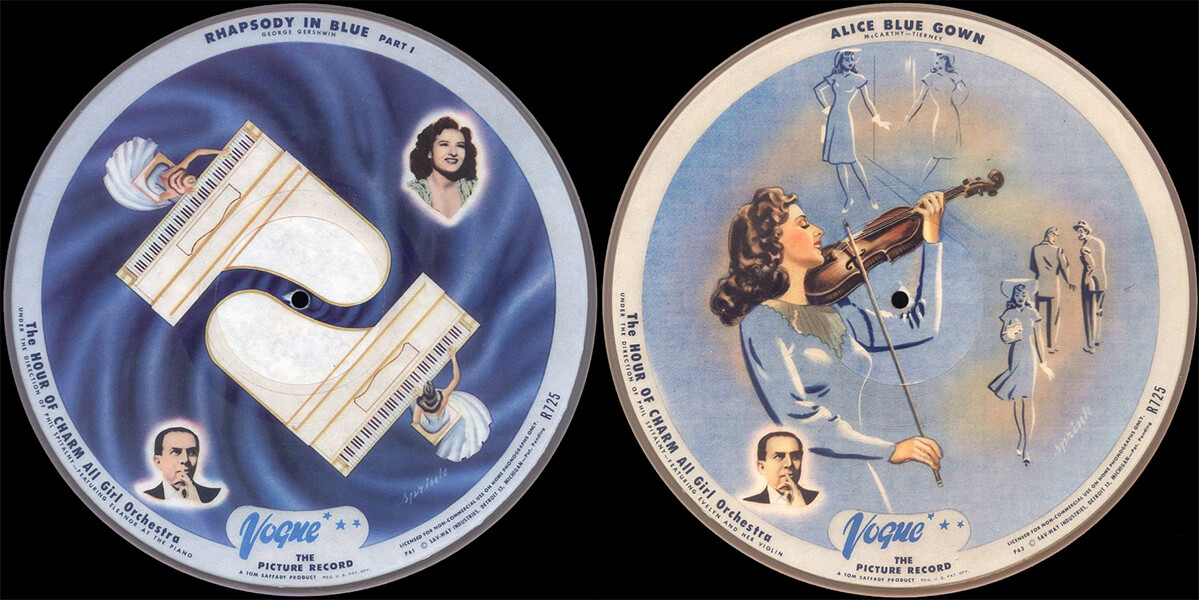
Julliard graduate Evelyn Kaye (1911-1990) was star of the show, featured on her “Magic Violin” — a 1756 Bergonzi. She was concertmaster, wrote most of the arrangements, kept an eye on the charming young ladies and was Spitalny’s lover. The couple eventually wed around the time that the orchestra disbanded. They successfully shifted to songwriting and remained happily married until Phil’s passing in 1970.
The complete opposite of Hour of Charm was the sassy Melodears swing band. Modeled on the popular Casa Loma Orchestra, they were fronted by Ina Rae Hutton the “Blonde Bombshell of Rhythm.”
The Melodears: All-female Swing Orchestra
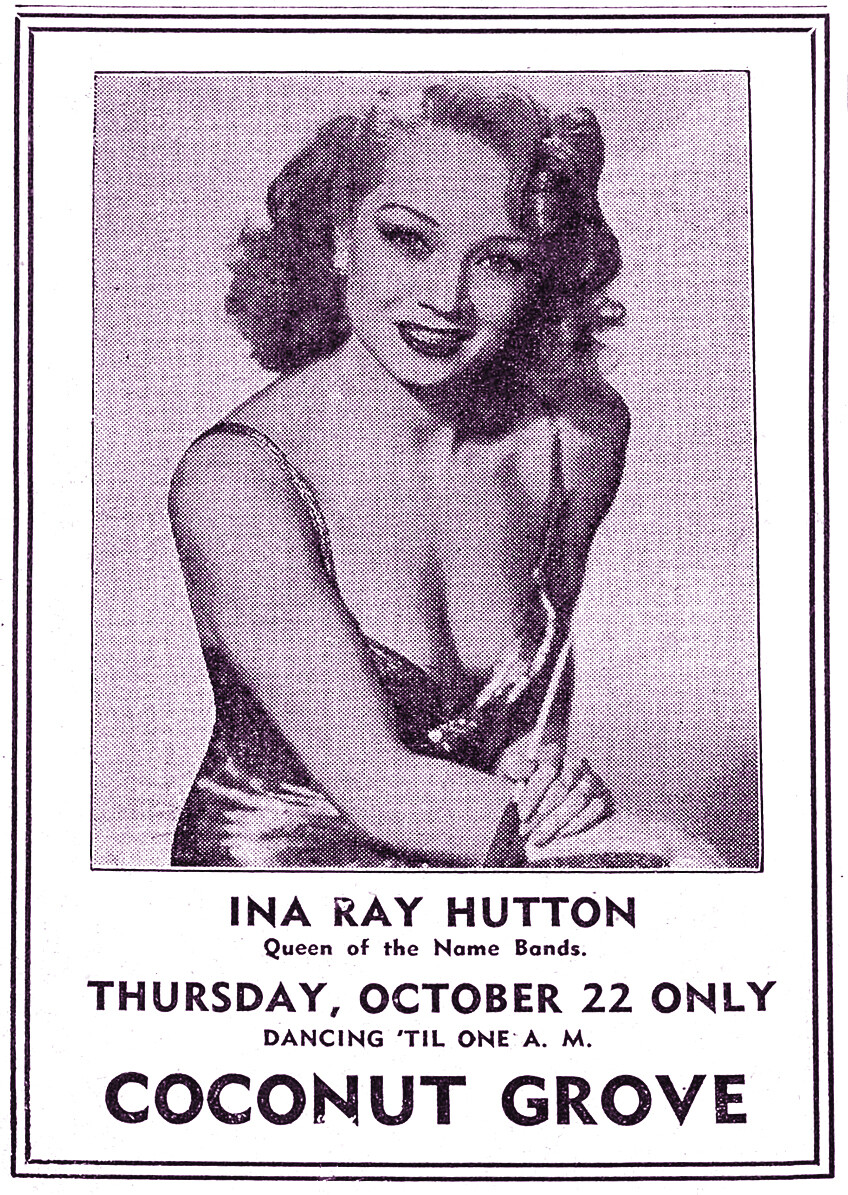
Ina Ray Hutton (Odessa Cowen, 1916-1984) became leader of the 15-piece all-female Melodears in 1934 at the initiation of promoter and agent Irving Mills. Hutton began her show business career tap dancing at age 8 or 9, progressing through Broadway, Ziegfeld Follies, movies and television.
Melodears – Accent on Girls
The Melodears (1934-39) were a decent Swing band playing good charts with enthusiastic riffing and hot solos. They made a dozen records, appearing in two feature length films and numerous movie shorts. Their best material (and the music heard here) are from Paramount film shorts of 1936-37 where Ina Rae is occasionally seen and heard tap dancing.
A lubricious platinum blonde who was married and divorced six times, Ina Ray went on to lead all-male bands through the late 1940s. She reorganized an all-female group that appeared on her nationally televised “Ina Rae Hutton Show” produced at KTLA-TV in Los Angeles, 1951-56.
Hutton – Melodears clip – (1936-37) Truckin,’ High Steppin,’ Melodear Swing, Suzi-Q
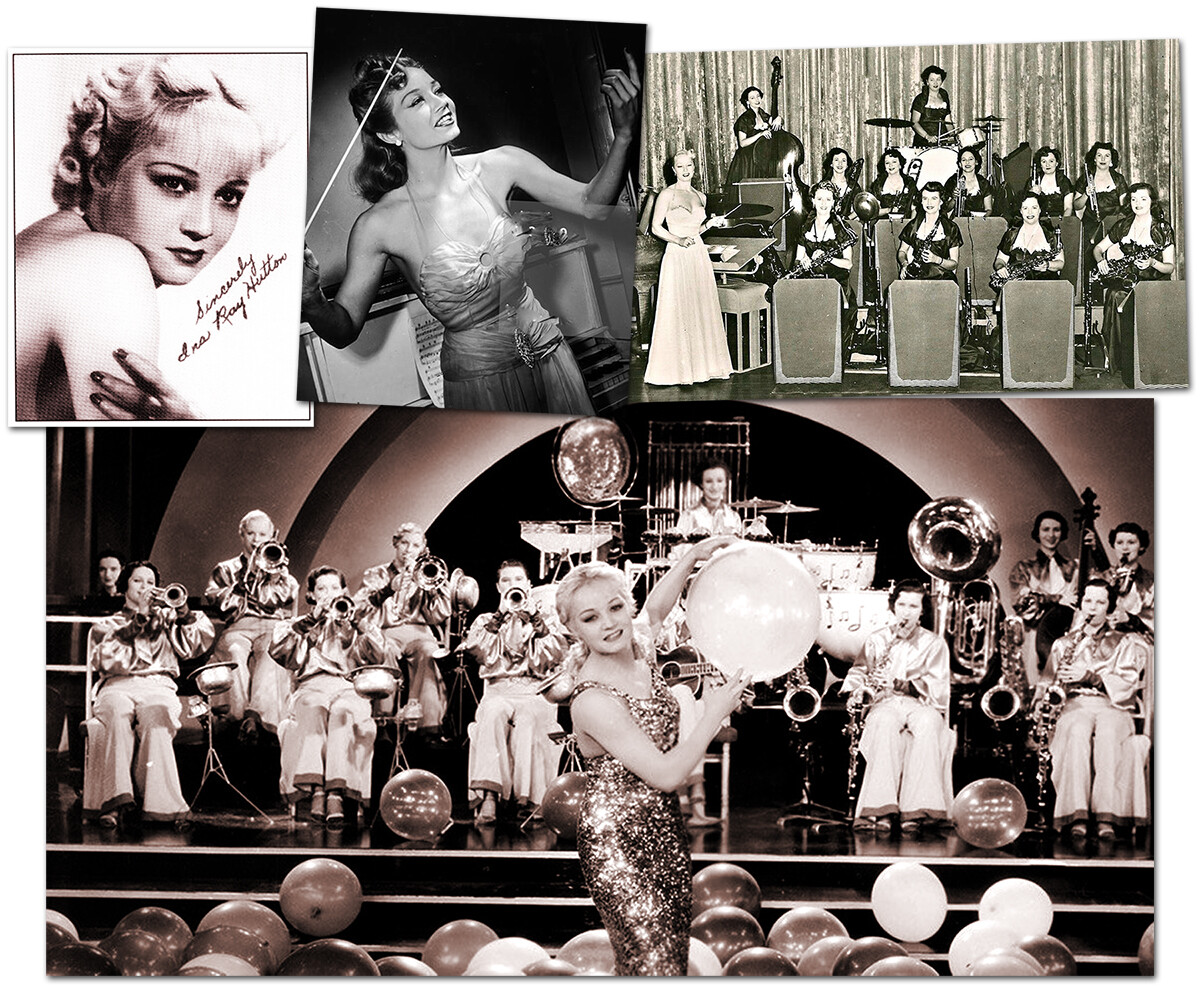
It’s remarkable and regrettable that the Melodears were the only all-women Swing band in the 1930s to make records. Clearly, they were NOT the only “all girl” big band, just the only one to appear widely on film and disc. Other touring and performing ensembles of the era were the Darlings of Rhythm, The Harlem Play-girls, Dixie Rhythm Girls and Eddie Durham’s All-Star Girl Orchestra.
The Prairie View Co-eds
The Texas-based Prairie View Co-eds were among the more successful African American all-women performing bands. They were similar to the International Sweethearts of Rhythm, and in fact several musicians rotated through both bands. Persisting into the early 1940s, the Prairie View Co-eds toured nationally and appeared regularly at the Apollo Theater in Harlem.
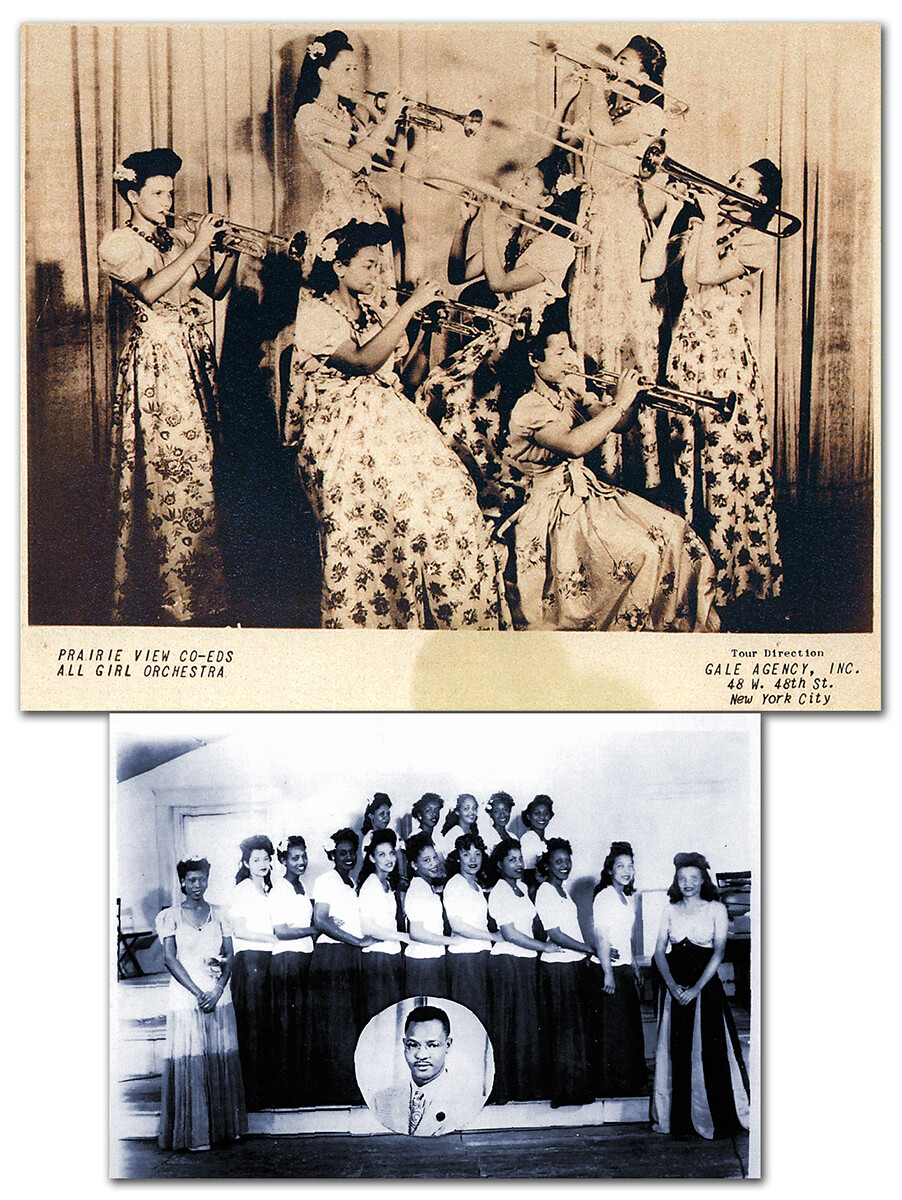
A small set of talented, beautiful, tough and dynamic women shaped early Jazz, Blues and Swing. They succeeded despite the resistance, skepticism, hostility or ridicule of their critics and male peers. This is merely an introduction and not a comprehensive survey of the talented female musicians who expressed and supported themselves playing Jazz, hot music and Blues.
In part two you’ll meet more charismatic and dynamic women. Highlighted are Lil Hardin, an arranger, composer and bandleader who was midwife to Jazz on record; Ma Rainey, the tough and independent “Mother of the Blues;” hot jazz violinist Ginger Smock; and Valaida Snow, a gifted trumpet player and singer. Mary Lou Williams, who was a formidable jazz composer, piano player, arranger, bandleader and revolutionary modernist is featured.
Dynamic Women of Early Jazz and Classic Blues, Pt 2
Sources and further exploration:
Black Beauty, White Heat: A Pictorial History of Classic Jazz 1920-50, Frank Driggs and Harris Lewine (Da Capo Press 1995)
Jazz Records, 1897-1942 [discography], Brian Rust (Arlington House, 1978)
Of Minnie the Moocher and Me, Cab Calloway (Thomas Crowell, 1976)
Swing Shift: “All Girl” Bands of the 1940s, Sherrie Tucker (Duke University, 2000)
The New Grove Dictionary of Jazz (St. Martin’s Press, 1988)
LINKS:
Lil Hardin on JAZZ RHYTYM
Bessie Smith and Ma Rainey on JAZZ RHYTHM
Women of Jazz and Blues – Five radio programs on JAZZ RHYTHM
Dave Radlauer is a six-time award-winning radio broadcaster presenting early Jazz since 1982. His vast JAZZ RHYTHM website is a compendium of early jazz history and photos with some 500 hours of exclusive music, broadcasts, interviews and audio rarities.
Radlauer is focused on telling the story of San Francisco Bay Area Revival Jazz. Preserving the memory of local legends, he is compiling, digitizing, interpreting and publishing their personal libraries of music, images, papers and ephemera to be conserved in the Dave Radlauer Jazz Collection at the Stanford University Library archives.



